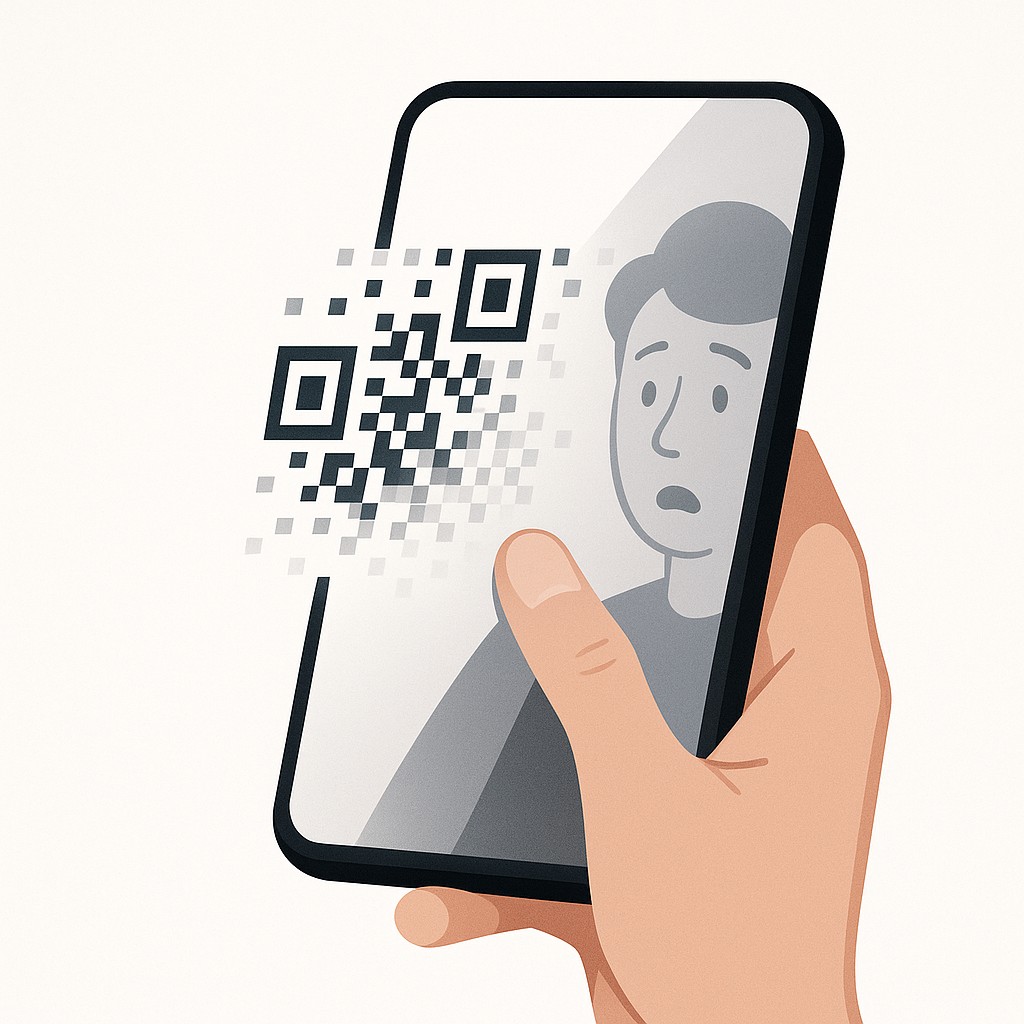How to analyze product tradeoffs: turning guardrails into clarity
How to analyze product tradeoffs: turning guardrails into clarity

When Frustration Vanishes: Turning the QR Code Block Into Clarity
It happened on a Tuesday afternoon—one of those moments that sticks mostly because it’s so, well, silly. I’d just earned a free sandwich from Chick-fil-A and wanted to share the joy with my spouse. Naturally, I tried to screenshot the loyalty QR code on my phone. But as soon as I tapped, the code vanished. Not faded out or blurred. Poof—like I was never supposed to see it. Honestly, I felt pretty annoyed. Five seconds before, sharing a perk felt simple. Five seconds after, I was staring at an empty rectangle and wondering who, exactly, built this obstacle.
Instead of stewing, something switched. I used to just sigh and move on from moments like this—accept the tech as a black box and try not to think about it. But this time I got curious. The annoyance was real, blocked right at the finish line, but it nudged me to think about how to analyze product tradeoffs. Curiosity took over.

Why would someone make it this hard? Was this a thoughtful, data-driven decision, or a cheap shot at point-sharing partners? There’s a bigger question threaded underneath: how often do features like these come from careful research, and how often are they quick fixes or uninformed guardrails?
Here’s the shift—and it’s a surprisingly powerful one. When we take a minute to examine why these annoying constraints exist, we turn frustration into clear, testable context. That’s how better engineering—and better teamwork—actually starts.
Finding the Why Behind “Annoying” Loyalty Guardrails
First things first, I can’t pretend to know exactly why Chick-fil-A blocks screenshots of their loyalty QR codes. I’m not inside their product meetings, and I don’t see how their backend works day to day. But I can lay out the main pressures and tradeoffs that drive these decisions to help you understand system constraints—especially since they come up in so many other apps, platforms, and programs. When you hit one of these constraints, looking for categories like security, speed, economics, or privacy helps you shape your questions and test solutions, instead of getting stuck guessing intent.
Let’s start with the security angle. In loyalty programs, preventing code reuse or mass sharing isn’t just a neat feature. It’s a well-known pattern. Abusers may share codes publicly, stack codes, exploit loopholes, manipulate promos, or use automated tools to generate or duplicate codes—which is why one-time use matters; see ekata.com. Blocks like this are there so the code only works for you, just once, and not for every group chat or grainy screenshot that escapes into the wild.
Now, zoom out to the checkout counter. Hear me out—when you’re standing in line with a dozen others, speed and certainty matter more than making every edge case easy. Features like these aren’t just stopping screenshots. They’re aiming for smooth, predictable handling when things get busy. Speed at checkout matters far more than on the landing page, which shapes these operational guardrails. So sometimes, a little inconvenience for a few users is traded off for a better, faster flow for everyone.
The economics layer is where things get especially interesting. Every loyalty program models things like redemption rates and breakage—the percentage of rewards that never actually get used. When sharing is easy and codes live forever, breakage drops, tons more rewards get redeemed, and suddenly margins and program viability are at risk. Guardrails—even frustrating ones—help a business survive and keep perks flowing rather than accidentally undermining the whole program. So every “annoyance” may actually be what protects the benefits you enjoy.
And then there’s privacy and security standards. Sometimes guardrails don’t even come from the loyalty system designers directly. Screenshot-blocking features can align with broader platform guidance and compliance requirements. iOS gives apps a tool to detect when a screen’s being captured, allowing them to enforce privacy and security standards. It’s not just about one sandwich code. It’s a whole ecosystem encouraging privacy practices that are harder to sidestep.
Put together, that single “annoyance” isn’t just some random obstacle. It’s usually several overlapping guardrails that make sense when you look at tradeoffs. Now, when one pops up, you have actual categories to test and discuss, not just frustration driving the conversation.
Quick tangent—last year I accidentally sent a friend a screenshot of a concert ticket instead of using the app’s sharing feature. Turns out, the barcode didn’t work at all when the venue scanned it, and we spent about fifteen awkward minutes at the door, swapping phones and searching emails. The digital guardrail mostly blocked a shortcut, but it also saved us (in a weird way) from sharing tickets in a way that could get voided. Looking back, the system’s friction was more annoying in the moment than in hindsight. It’s messy, but now I pause before just screenshotting anything with a barcode.
Turning Friction Into Action: How to Analyze Product Tradeoffs in Five Steps for Clarity and Collaboration
Step one’s simple, but most people skip it—just name the flow and the guardrail directly. I tried to screenshot a QR code, expecting to save or share it with my spouse. What really happened: the code vanished the instant I tapped, clearly designed to prevent something I’d taken for granted. The system wasn’t playing along.
Next, don’t just guess why it happened. Lay out hypotheses across five buckets: security, fraud and abuse, operations, economics, and privacy/compliance. Fraud prevention stands out. One-time codes stop sharing and reuse that could drain the program. Operations play a part by keeping redemptions smooth at peak times. Economics push for higher breakage to protect margins. And privacy—screenshots risk extra data leaking, especially if platform rules reward transient codes. This framing shows how to analyze product tradeoffs, transforming a single headache into a structured search for options.
Third, I don’t get stuck debating possible reasons. Scrappy validations are the move—try redeeming on a second device, ask a cashier what shows up, dig into the app’s help docs, or compare with competitors. Sometimes, checking iOS platform notes reveals more than a dozen speculative team debates ever could. Honestly, the five-minute poke wins every time. There’s real clarity hiding in quick experiments.
Fourth, when you’re talking to product, risk, or support teams, frame your findings as hypotheses to test, not demands to change. “Here’s what I saw, here’s what might be driving it, and here’s a small test we could run.” Suggest metrics to measure friction or security impact so you can evaluate product tradeoffs, or propose a lightweight variant—maybe a feature flag—without assuming anything’s broken. The key is making it a learning bet, not a complaint. And here’s the proof: framing requests cuts down back-and-forth, which lets both teams focus fast on solutions, not speculations. Most product folks aren’t allergic to tradeoffs. They just want the rationale clear and easy to test. You’re building bridges, not burning them.
Finally, every flow needs a decision. Accept the guardrail if it’s working well, adjust your design or UX to match, or advocate for a constrained change with eyes wide open to the tradeoffs. When you unpack the friction, you stop guessing and start collaborating—so your next solution’s actually grounded in reality, not just frustration.
Guardrails Everywhere: Seeing the Same Tradeoffs in Everyday Tech
Rate limits and AI guardrails might feel impersonal at first—so design for rate limits by anticipating a 429 error popping up or a model blocking your prompt. Six months ago I would just mutter and reload the page, assuming it was some arbitrary computer rule. Now I stop myself. Most of the time, those constraints are pricing a limited resource or making sure service quality doesn’t tank for everyone else. It isn’t anyone being hostile. It’s just fairness and economics at play. That’s why my batching and retry logic gets shaped by backoff windows, not just by pure impatience.
Logging is another spot where guardrails show up, but here the pressure tilts toward user safety. If you’ve ever wanted full raw content in your logs and hit a closed door, there’s probably a reason. Redacting customer data or limiting what ends up in logs shrinks the fallout of any breach and protects people from accidental exposure. The design challenge is to bake in enough observability without crossing privacy lines. Accepting those boundaries early means fewer rewrites and compliance headaches down the road.
Then there’s checkout friction—think extra authentication steps or 2FA. Yes, it slows things down and can annoy users (I admit, I grumble myself). But every time I look at why these steps exist, the tradeoff is clear: less fraud and fewer chargebacks. Added complexity for some, big savings for the business overall. You don’t want to punish regulars with endless pop-ups, though. So, offset the friction with copy that explains what’s happening, offer progressive disclosure so only risky interactions get extra checks, and always route trusted users through faster paths if you can. These tweaks don’t eliminate guardrails; they make real-world use bearable and secure.
Let’s loop back to that QR code block. If you want to change or challenge a guardrail, run a simple experiment before making a big shift. Try granting a window for redemption or testing an alternate flow with metrics like fraud rates and user drop-off. Success isn’t proving the guardrail “wrong”—it’s finding a way that users and operations both stay safe.
These moments aren’t blockers—they’re signals. Every constraint, no matter how inconvenient, reveals a deliberate tradeoff. When we stop blaming and start tracing those choices back to their roots, the systems we build (and fix) actually get stronger.
For all the logic I try to apply, sometimes I still catch myself wishing some of these guardrails would just disappear for a day. But for now, I accept there’s a gap between convenience and safety I haven’t quite bridged.
Turn your ideas, notes, and experiments into clear, platform-ready posts with our AI content generator, so you can quickly draft articles, threads, and updates without the slog.
Objections: Curiosity vs. Pressure and Getting Stakeholders Onboard
Let’s get real about the first worry—time pressure. If you’re working against the clock (and who isn’t?), it feels wild to add ten extra minutes just to dissect a “why.” But here’s the truth. A short burst of structured curiosity up front saves you weeks of rewrite and endless debate down the line. I’ve wasted hours fixing flows I didn’t fully understand. Ten minutes is cheap compared to that.
Feeling nervous about looping in product or risk teams is normal too. It can seem like curiosity is pushback, or proof you don’t agree. Flip that. Your questions show you care about what really matters. You’re inviting them to reason about tradeoffs, not putting their work on trial. Framing your ask as a “let’s test this together” almost always opens doors.
Next time a guardrail or constraint stops you cold—like that vanished QR code—write down your expected flow, jot a few possible reasons why the block exists, and sketch one low-risk test or question. That tiny pause makes what comes next purposeful, not just reactive.
So, let’s get a conversation going. What’s a small inconvenience that got you curious about the reasoning behind it? Let me know in the comments—and like this post if it resonates!
This is the expected criteria for your final answer: Free-form (raw) output is acceptable. Follow the task description carefully.
you MUST return the actual complete content as the final answer, not a summary.
Begin! This is VERY important to you, use the tools available and give your best Final Answer, your job depends on it!
Enjoyed this post? For more insights on engineering leadership, mindful productivity, and navigating the modern workday, follow me on LinkedIn to stay inspired and join the conversation.
You can also view and comment on the original post here .
